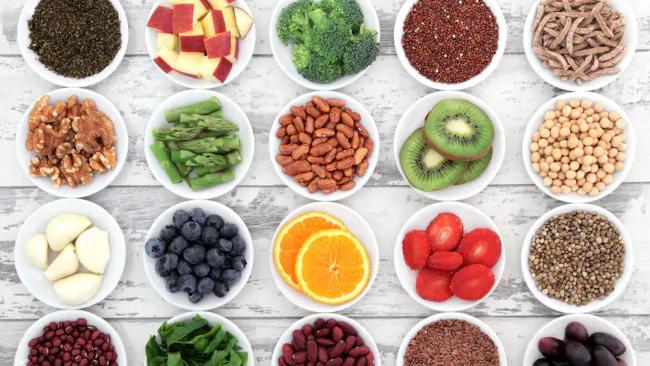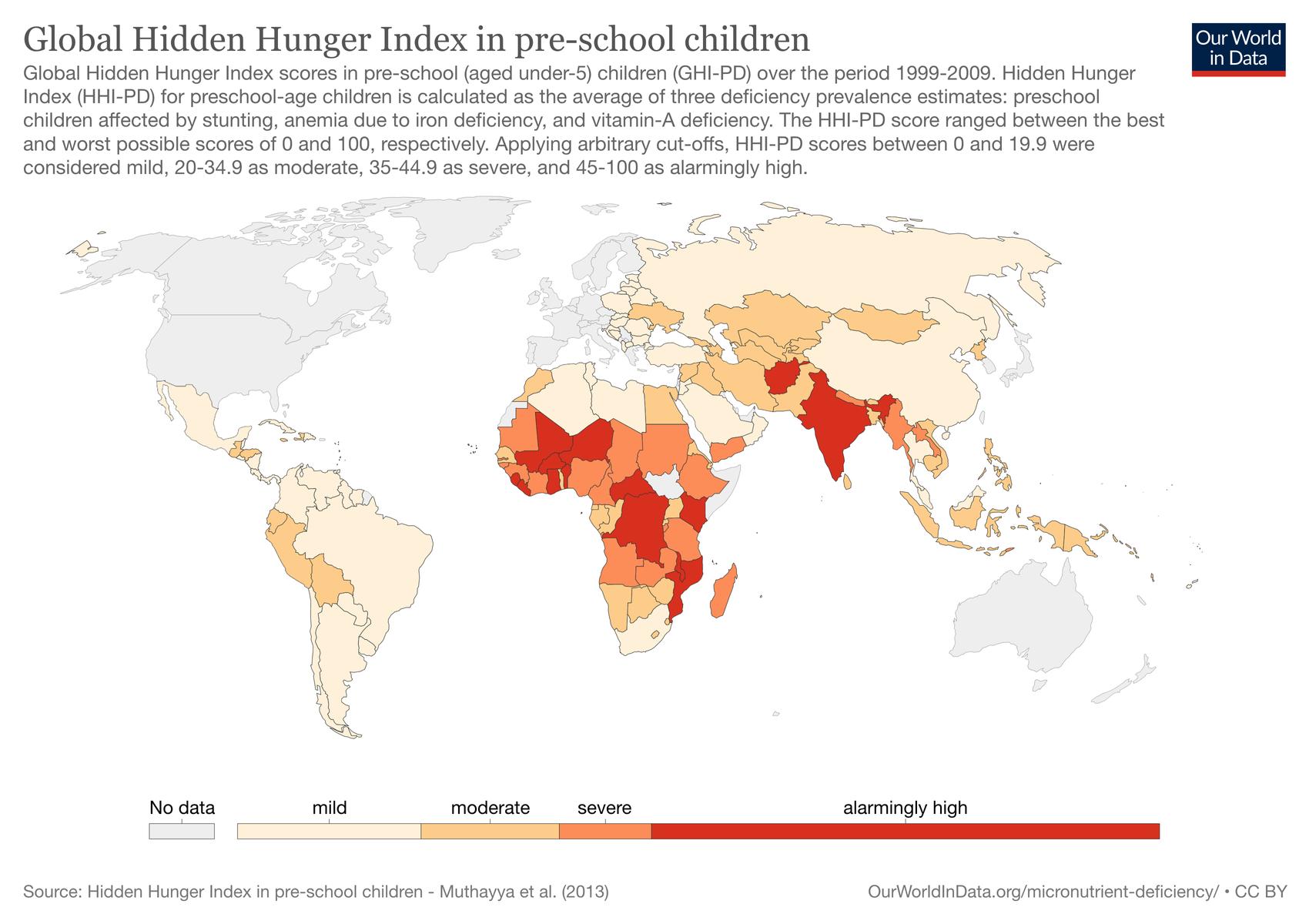
4 minute read
Micronutrient deficiencies (Meg Tharp
Micronutrient Deficiencies
Coined "hidden hunger" because of its ability to negatively affect even wellfed individuals, deficiency in micronutrients affects individuals across the globe.
Advertisement
What are Micronutrients?
Micronutrients are essential components of the human diet necessary for proper physiologic functioning, which are consumed in small quantities.
Some of the most common and most important micronutrients include iron, zinc, calcium, iodine, and important vitamins such as Vitamin A, BVitamins, and Vitamin C.
Where can Micronutrients be Found?

Fruits, vegetables, nuts and seeds, beans and legumes, whole wheat, fish, eggs, high-quality meat, and dairy can all be excellent sources of
Why is hidden hunger a problem?
Deficiencies in micronutrients can lead to issues such as:
immunodeficiency physical and mental developmental delays (especially in children) blindness and vision problems general diminished quality of life and ability to complete daily tasks
Though all people can experience negative effects from prolonged inadequate intake of or access to micronutrients, children and pregnant women are most drastically affected by this issue due to the role micronutrients can plan in proper growth and development (13).
Nations most affected by hidden hunger can be seen in Figure 6. Much of what contributes to high rates of hidden hunger can simply include lack of access to quality food sources due to financial and/or infrastructure barriers. However, even the most wealthy countries can still be affected by this.
Global Hidden Hunger Scores Among Preschool-Aged Children
(determined based on prevalence of stunting, anemia due to iron deficiency, and Vitamin A deficiency)
Ways to Reduce or Prevent Micronutrient Deficiencies:
Taking multivitamins Supplementation campaigns (efforts to administer micronutrient supplements to at-risk populations) Food fortification (the process of adding micronutrients to food, i.e. iodized salt, folic acid and iron added to bread) (12)
Are prevention strategies effective?
Efforts to reduce the prevalence and/or effects of micronutrient deficiencies have shown positive effects suggesting they are indeed effective in combatting this issue. Figure 7 shows the positive effect on growth seen in schoolchildren taking a zinc + multivitamin supplement, a change in height of 3.6 cm +/- 0.6 cm for children with no supplementation, and 4.9 +/- 1.3 cm for children taking a zinc + multivitamin supplement.
No supplement
With zinc + multivitamin
0 1 2 3
Figure 7. Rerksuppaphol S, Rerksuppaphol L. Effect of zinc plus multivitamin supplementation on growth in school children. Pediatr Int. doi: 10.1111/ped.13011. Published August 31, 2016. Accessed March 24th, 2021.
"I personally see this as a drastically overlooked issue for which there is insufficient research. I believe every country in the world can be affected like this and it can be extremely beneficial to even be slightly more aware of your personal micronutrient access and intake." - Meg Tharp
References
Gundersen C, Ziliak JP. Food Insecurity And Health Outcomes. Health Aff (Millwood). 2015;34(11):1830-1839. doi:10.1377/hlthaff.2015.0645 Diet, nutrition and the prevention of chronic diseases: report of a joint WHO/FAO expert consultation, Geneva, 28 January - 1 February 2002. Accessed February 18, 2021. https://www.who.int/publications-detail-redirect/924120916X Morley J. Protein-Energy Undernutrition (PEU) - Nutritional Disorders. Merck Manuals Professional Edition. Accessed February 18, 2021. https://www.merckmanuals.com/professional/nutritional-disorders/undernutrition/protein-energy-undernutrition-peu Elliot K. Food Security in Developing Countries: Is There a Role for the WTO? Center For Global Development. Accessed February 18, 2021. https://www.cgdev.org/publication/food-security-developing-countries-there-role-wto Bjarnadottor, A. 7 Nutrient Deficiencies That Are Incredibly Common. Healthline. https://www.healthline.com/nutrition/7-common-nutrient-deficiencies. Accessed February 24, 2021. Publishing HH. The larger role of micronutrients. Harvard Health. https://www.health.harvard.edu/staying-healthy/the-larger-role-of-micronutrients. Accessed February 26, 2021. Department Pby SR, 27 N. Global Hunger Index 2020: countries most affected by hunger. Statista. https://www.statista.com/statistics/269924/countries-most-affected-byhunger-in-the-world-according-to-world-hunger-index/. Published November 27, 2020. Accessed February 26, 2021. Ritchie H, Roser M. Micronutrient Deficiency. Our World in Data. https://ourworldindata.org/micronutrient-deficiency. Published August 11, 2017. Accessed February 26, 2021. Díaz JR, de las Cagigas A, Rodríguez R. Micronutrient deficiencies in developing and affluent countries. Eur J Clin Nutr. 2003;57 Suppl 1:S70-S72. doi:10.1038/sj.ejcn.1601820 Prevent iron deficiency anemia during pregnancy. Mayo Clinic. https://www.mayoclinic.org/healthy-lifestyle/pregnancy-week-by-week/in-depth/anemia-during-pregnancy/art20114455. Published October 25, 2019. Accessed February 26, 2021. Vitamin B12 Deficiency Anemia. Johns Hopkins Medicine. https://www.hopkinsmedicine.org/health/conditions-and-diseases/vitamin-b12-deficiencyanemia#:~:text=Key%20points%20about%20vitamin%20B12%20deficiency%20anemia&text=get%20enough%20oxygen.-,Without%20enough%20oxygen%2C%20your%20body%20 can%27t%20work%20as%20well,fatigue%2C%20and%20increased%20heart%20rate. Accessed February 26, 2021. Allen L, de Benoist B, Dary O, Hurrell R. Guidelines on food fortification with micronutrients. https://www.who.int/nutrition/publications/guide_food_fortification_micronutrients.pdf. Published 2006. Vitamin A Deficiency in Children. UNICEF DATA. https://data.unicef.org/topic/nutrition/vitamin-a-deficiency/. Published November 11, 2020. Accessed February 26, 2021. Verchot M. 5 Ways to Improve Global Food Security. Treehugger. Accessed February 28, 2021. https://www.treehugger.com/ways-improve-global-food-security-4858809 Misselhorn A, Hendriks S. A systematic review of sub-national food insecurity research in South Africa: Missed opportunities for policy insights. PLOS ONE. 2017;12:e0182399. doi:10.1371/journal.pone.0182399 Woods M. Common Solutions to Food Insecurity Worldwide. The Borgen Project. Published February 1, 2018. Accessed February 28, 2021. https://borgenproject.org/commonsolutions-to-food-insecurity-worldwide/ Food Insecurity in America: Causes and Solutions | Feeding America. Accessed February 28, 2021. https://www.feedingamerica.org/hunger-in-america/food-insecurity Peace Corps. Global Issues: Food Security. Accessed February 28, 2021. https://www.peacecorps.gov/educators/resources/global-issues-food-security/ Global Strategy on Diet, Physical Activity and Health - 2004. Accessed February 28, 2021. https://www.who.int/publications/i/item/9241592222 Afshin A, Sur PJ, Fay KA, et al. Health effects of dietary risks in 195 countries, 1990–2017: a systematic analysis for the Global Burden of Disease Study 2017. The Lancet. 2019;393(10184):1958-1972. doi:10.1016/S0140-6736(19)30041-8 FAO Hunger Map 2015 - World. ReliefWeb. Accessed March 1, 2021. https://reliefweb.int/map/world/fao-hunger-map-2015 Country Nutrition Profiles. Accessed April 12, 2021. https://globalnutritionreport.org/resources/nutrition-profiles/ Food Insecurity In The U.S. By The Numbers. NPR.org. Accessed April 12, 2021. https://www.npr.org/2020/09/27/912486921/food-insecurity-in-the-u-s-by-the-number







